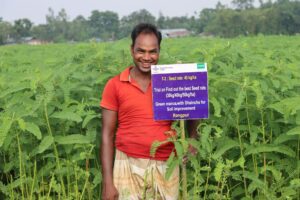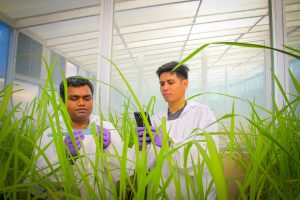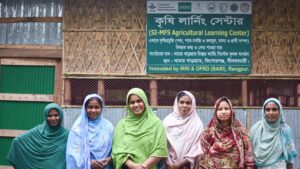
In a few weeks (31 October to be exact), our population clock, which we have synchronized to match the medium variant in the United Nations’ recent 2010 Revision of the World Population Prospects, will reach the 7 billion milestone. It does not escape me that almost half of this mass of humanity continues to depend on rice for its staple food.
What of the future? If we follow the UN’s medium predictions, our clock will show around 9 billion by mid-century (yellow line on the graph, click to enlarge)—now less than 40 years away—and level off at around 10.1 billion by 2100. However, if global fertility were just 0.5 child more per woman than expected, our clock in 2050 and 2100 could show as many as 10.6 billion and 15.8 billion (red line on graph), respectively—very scary and hardly imaginable! Going the other direction with global fertility being just 0.5 child less per woman than expected, the clock would show 8.1 billion in 2050 and then reverse course to only 6.2 billion at the end of the century (green line on graph). The medium prediction is probably more likely, at least for 2050, since people who will be 40 years old and older by then have already been born.
 Although we should take all three scenarios in the graph “with a grain of salt,” I think it is probably most prudent to take the middle road. If world population does stabilize at around 10 billion by the turn of the century, at which it hopefully will have reached a replacement only level, we should be able to meet the still formidable challenge of feeding that many people with focused and cutting-edge agricultural research. We have the tools available—particularly in rice research now driven by the Global Rice Science Partnership (GRiSP)—to increase productivity significantly in the coming decades.
Although we should take all three scenarios in the graph “with a grain of salt,” I think it is probably most prudent to take the middle road. If world population does stabilize at around 10 billion by the turn of the century, at which it hopefully will have reached a replacement only level, we should be able to meet the still formidable challenge of feeding that many people with focused and cutting-edge agricultural research. We have the tools available—particularly in rice research now driven by the Global Rice Science Partnership (GRiSP)—to increase productivity significantly in the coming decades.
Shining examples of our impressive research progress to help us tackle problems associated with more people and less land are Monitoring an inconvenient divergence showcased in IRRI’s 2010 Annual Report. In addition, advances we are making in both favorable and unfavorable rice environments are featured in this issue of Rice Today, where we take close looks at the Impact of the Irrigated Rice Research Consortium (IRRC) and the Consortium for Unfavorable Rice Environments (CURE), partners in the highlands.
To underscore the population dilemma for this issue, we feature two CGIAR (Consultative Group on International Agricultural Research) directors general as special columnists—Papa Seck, who leads the Africa Rice Center, one of our major GRiSP partners; and Shenggen Fan, at the helm of the International Food Policy Research Institute in Washington, D.C. Assuming the 9 billion or so scenario for 2050, Dr. Seck believes that sub-Saharan Africa will play a significant role in global food security in the coming decades. This is because, unlike Asia and Europe, where the availability of potential land and water for agriculture is declining, Africa still possesses a large reservoir of underused agricultural land and water resources. In the Grain of Truth section, Dr. Fan warns that population growth and land constraints are not the only forces of change that are challenging food security, especially where rice is concerned. We also have to add to the mix increased input and labor costs, water constraints, and climate change.
Adhering to the UN’s medium prediction, Dr. Jason Clay of the World Wildlife Fund (in a Global Harvest Initiative Policy Issue Brief) calculates that, if we are to feed the 9+ billion people sharing our planet by 2050, we will need to produce as much food in the next 40 years as we have in the last 8,000! As daunting as that concept is, I believe we can improve productivity enough to achieve it. Ironically, it will be due to what I call the “convenient convergence” of solving simultaneously today’s problems of floods, drought, seawater incursion, etc., and tomorrow’s problems tied to inevitable climate change and the continuing “inconvenient divergence” of more people and less land.
Robert S. Zeigler
Director General








